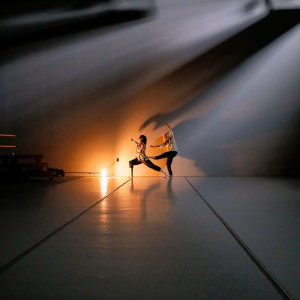Crossing the border with performance art: Documentary by Amherst native Amber Bemak profiles the Mexican-Chicano artist Guillermo Gómez-Peña
| Published: 03-24-2023 2:18 PM |
When she was an undergraduate at Antioch College, Amber Bemak studied film before moving on to get an MFA in film, video and new media from the School of the Art Institute of Chicago.
But Bemak, 45, who grew up in Amherst and now teaches film and media studies at Southern Methodist University in Texas, says she didn’t approach cinema strictly from the standpoint of learning to direct, write scripts, handle a movie camera or develop other conventional skills.
“I studied film as a means of activism, a way to challenge conventional narratives and structures,” she said in a recent interview. “I was also interested in looking at the relationship between filmmakers and the subjects of their films — that basic power structure that’s always been there.”
Bemak, a graduate of Amherst Regional High School, has used that approach in co-directing and producing a range of documentary and experimental films on subjects such as Tibetan Buddhism, unconventional families, women’s bodies and more.
Her latest project is her first solo, feature-length documentary, a profile of the noted performance artist and writer Guillermo Gómez-Peña, a native of Mexico who lives part time in San Francisco and has used the U.S-Mexico border for much of his work, exploring themes of cross-cultural identity, language, colonization, sexuality and more.
After opening last year at the Brooklyn Academy of Music and playing in a number of other places, most recently in London, “100 Ways to Cross the Border” comes to the Amherst Cinema March 30 at 7 p.m.
Bemak and the film’s creative producer, Nadia Granados, will discuss the documentary afterward.
In a recent phone call, Bemak said she’d been a longtime admirer of Gómez-Peña and had gotten to know him “and some of the people in his circle” while living in Mexico City — Gómez-Peña’s birthplace — for a couple years in 2015-2016.
Article continues after...
Yesterday's Most Read Articles
“He’s incredibly famous, incredibly talented, and he’s toured all over the world,” said Bemak, who notes that Gómez-Peña won a MacArthur Fellowship, the “genius” grant, in 1991, becoming the first Chicano artist to receive the award.
“I approached him about doing a documentary, and he was open to that,” said Bemak, who’s currently in the Valley on parental leave (she has an 11-month old daughter, Mandarava). “But I didn’t want to make a conventional documentary, because he’s not a conventional artist.”
Indeed, “100 Ways to Cross the Border” dispenses with any over-arching narration and instead relies on informal interviews and conversations in both English and Spanish, archival performance footage and interviews, and animation.
There are also scenes with members of Gómez-Peña’s performance art troupe, La Pocha Nostra, engaged in free-form actions, like filling plastic garbage bags with rainwater and dumping the contents on their heads.
Bemak makes herself part of the film in places, too, in some playful bits in which she jousts a bit with Gómez-Peña in what appear to be staged scenes, such as one where the artist accuses Bemak of stereotyping his work.
Bemak even appears buck naked a few times, as if to emphasize that she’s not the the all-powerful director in total command of the film.
“Guillermo is considered the first performance artist to address the [U.S.-Mexico] border,” she said. “He’s also made the case for years that people can have multiple identities, that identity is not fixed by the place you live of where you were born.”
Making that kind of fluid dynamic a central theme of her movie was paramount, Bemak said.
In one scene, filmed in Mexico City, Gómez-Peña spins a globe and says, “To me the border is a spiral where multiple cultures converge and collide … the parameters of language and nationality are constantly shifting.”
Performance art itself, he adds, is a way to break down barriers — physical, cultural, and sexual.
“It’s an action against the terror generated by politicians, organized crime, and mass culture. It’s a kind of a cultural and spiritual exorcism ... The body is a space for revision of identity.”
Bemak says she didn’t specifically address the increasing militarization of the border, or the growing anti-immigrant sentiment that’s been fanned in the U.S., especially while she was making the film over the last several years.
Those issues crop up, nevertheless, when the camera settles on sections of the wall the U.S. government and some southern states have built. Gómez-Peña also talks about how the border has become more restricted since he first came to the U.S., in California, as a college student in the late 1970s.
He offers a witty note at one point about cultural stereotypes, saying he’s been more likely to be stopped by U.S. border guards if dressed conservatively because “they think I’m a drug dealer.”
But when he started putting on his mariachi costume to make that crossing, he adds, “Suddenly I became an amigo.”
The film offers a good bit of this sly humor, which seems in keeping with some of the satiric skits that members of La Pocha Nostra (“Our Little One”) are seen doing.
Near the beginning, Bemak, just off-camera, poses an opening question to the artist to try to define these actions: “OK, Gómez-Peña, you’re gonna hate me, but what the (bleep) is performance art?”
“Oh … hmmm,” says Gómez-Peña, seemingly perplexed by the question. The very next scene features a female member of La Pocha Nostra holding a rifle, or rifle replica, to the chest of another troupe member, a man with his hands clutched behind his head like a prisoner or hostage.
There’s also a brief interview with Gómez-Peña’s mother, who says her son is “completamente loco” (completely crazy) but that “I adore him.”
Michèle Ceballos Michot, a La Pocha Nostra member and dancer/teacher who grew up in Colombia and the U.S., describes how Gómez-Peña gave her a new way of seeing herself after she’d come to a point in her career, particularly as a ballerina, in which her age and looks had straight-jacketed her roles.
“Guillermo said to me, ‘You’re a performance artist,’” Michot says. “I realized I had all these parts of me that weren’t being explored.”
In one scene, she pirouettes around a swimming pool in a tutu, then dives into the water, coming out to grasp the legs of a soundman holding a boom mic, saying “Oh, Benjamin, I need a massage.”
Not that much of this has been easy for the artists. Gómez-Peña laments that they “inhabit the dark barrios of the periphery in the contemporary art world, and that will never change … I’ve won every international award possible, and still, I can’t pay my monthly bills.”
But, as he approaches 70 years of age, he says he’s going to keep up the fight to use art to break down borders and not be pigeonholed himself.
“I’ve been fighting for controlling my image only for 40 years, and the fight never ends.”
Steve Pfarrer can be reached at spfarrer@gazettenet.com.

 Upon Nancy’s Floor: 33 Hawley event celebrates iconic dancers, history, and a new dance floor
Upon Nancy’s Floor: 33 Hawley event celebrates iconic dancers, history, and a new dance floor Embracing both new and old: Da Camera Singers celebrates 50 years in the best way they know how
Embracing both new and old: Da Camera Singers celebrates 50 years in the best way they know how Time to celebrate kids and books: Mass Kids Lit Fest offers a wealth of programs in Valley during Children’s Book Week
Time to celebrate kids and books: Mass Kids Lit Fest offers a wealth of programs in Valley during Children’s Book Week Arts Briefs: A themed exhibit in Northampton, new opportunities for artists in Easthampton, and more
Arts Briefs: A themed exhibit in Northampton, new opportunities for artists in Easthampton, and more
